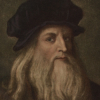Leonardo da Vinci

Leonardo da Vinci
Leonardo di ser Piero da Vinci, more commonly Leonardo da Vinci or simply Leonardoˈvintʃi] ; 15 April 1452 – 2 May 1519), was an Italian polymath whose areas of interest included invention, painting, sculpting, architecture, science, music, mathematics, engineering, literature, anatomy, geology, astronomy, botany, writing, history, and cartography. He has been variously called the father of paleontology, ichnology, and architecture, and is widely considered one of the greatest painters of all time. Sometimes credited with the inventions of the parachute, helicopter and tank,...
NationalityItalian
ProfessionPainter
Date of Birth15 April 1452
CityVinci, Italy
CountryItaly
The organ of perception acts more readily than judgment.
Music may be called the sister of painting, for she is dependent upon hearing, the sense which comes second and her harmony is composed of the union of proportional parts sounded simultaneously, rising and falling in one or more harmonic rhythms.
Fire destroys falsehood, that is sophistry, and restores truth, driving out darkness.
Constancy does not begin, but is that which perseveres.
Nothing will be left, Nothing in the air, nothing under the earth, nothing in the waters. All will be exterminated.
The wisest and noblest teacher is nature itself.
Common Sense is that which judges the things given to it by other senses.
The first object of the painter is to make a flat plane appear as a body in relief and projecting from that plane
When Fortune comes, seize her in front with a sure hand, because behind she is bald.
Vows begin when hope dies.
The painter who draws by practise and judgment of the eye without the use of reason is like the mirror which reproduces within itself all the objects which are set opposite to it without knowledge of the same.
He who has access to the fountain does not go to the water-pot.
The fox when it sees a flock of herons or magpies or birds of that kind, suddenly flings himself on the ground with his mouth open to look as he were dead; and these birds want to peck at his tongue, and he bites off their heads.
The mole has very small eyes and it always lives under ground; and it lives as long as it is in the dark but when it comes into the light it dies immediately, because it becomes known;--and so it is with lies.